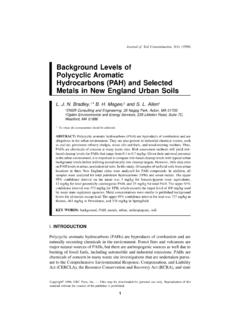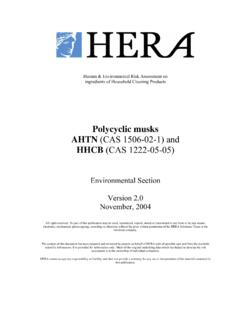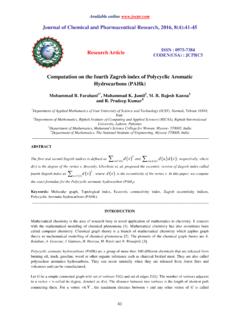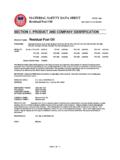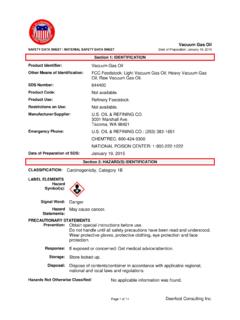Transcription of Introduction to solid waste management - cyen
1 solid waste management Introduction to solid waste management solid waste is the unwanted or useless solid materials generated from combined residential, industrial and commercial activities in a given area. It may be categorised according to its origin (domestic, industrial, commercial, construction or institutional);. according to its contents (organic material, glass, metal, plastic paper etc); or according to hazard potential (toxic, non-toxin, flammable, radioactive, infectious etc). management of solid waste reduces or eliminates adverse impacts on the environment and human health and supports economic development and improved quality of life.
2 A. number of processes are involved in effectively managing waste for a municipality. These include monitoring, collection, transport, processing, recycling and disposal. Reduce, Reuse, Recycle Methods of waste reduction, waste reuse and recycling are the preferred options when managing waste . There are many environmental benefits that can be derived from the use of these methods. They reduce or prevent green house gas emissions, reduce the release of pollutants, conserve resources, save energy and reduce the demand for waste treatment technology and landfill space.
3 Therefore it is advisable that these methods be adopted and incorporated as part of the waste management plan. waste reduction and reuse waste reduction and reuse of products are both methods of waste prevention. They eliminate the production of waste at the source of usual generation and reduce the demands for large scale treatment and disposal facilities. Methods of waste reduction include manufacturing products with less packaging, encouraging customers to bring their own reusable bags for packaging, encouraging the public to choose reusable products such as cloth napkins and reusable plastic and glass containers, backyard composting and sharing and donating any unwanted items rather than discarding them.
4 All of the methods of waste prevention mentioned require public participation. In order to get the public onboard, training and educational programmes need to be undertaken to educate the public about their role in the process. Also the government may need to regulate the types and amount of packaging used by manufacturers and make the reuse of shopping bags mandatory. Recycling Recycling refers to the removal of items from the waste stream to be used as raw materials in the manufacture of new products. Thus from this definition recycling occurs in three phases: first the waste is sorted and recyclables collected, the recyclables are used to create raw materials.
5 These raw materials are then used in the production of new products. The sorting of recyclables may be done at the source ( within the household or office) for selective collection by the municipality or to be dropped off by the waste producer at a recycling centres. The pre-sorting at the source requires public participation which may not be forthcoming if there are no benefits to be derived. Also a system of selective collection by the government can be costly. It would require more frequent circulation of trucks within a Figure 1. Colour coded recycling bins for neighbourhood or the importation of more waste separation at the source of production vehicles to facilitate the collection.
6 (source ). Another option is to mix the recyclables with the general waste stream for collection and then sorting and recovery of the recyclable materials can be performed by the municipality at a suitable site. The sorting by the municipality has the advantage of eliminating the dependence on the public and ensuring that the recycling does occur. The disadvantage however, is that the value of the recyclable materials is reduced since being mixed in and compacted with other garbage can have adverse effects on the quality of the recyclable material.
7 waste Collection waste from our homes is generally collected by our local authorities through regular waste collection, or by special collections for recycling. Within hot climates such as that of the Caribbean the waste should be collected at least twice a week to control fly breeding, and the harbouring of other pests in the community. Other factors to consider when deciding on frequency of collection are the odours caused by decomposition and the accumulated quantities. Descriptions of the main types of collection systems are given in the table below.
8 Table 1 Descriptions of the main collection systems. (Sourced from #Anchor- Collection-45656). System Description Advantages Disadvantages SHARED: Residents can bring out waste at any time Dumping at Residents and other Low capital Loading the waste into trucks is slow and designated generators are costs unhygienic. waste is scattered around location required to dump their the collection point. Adjacent residents waste at a specified and shopkeepers protest about the smell location or in a and appearance. masonry enclosure. Shared Residents and other Low operating If containers are not maintained they container generators put their costs quickly corrode or are damaged.
9 waste inside a Adjacent residents complain about the container which is smell and appearance. emptied or removed. INDIVIDUAL: The generators need a suitable container and must store the waste on their property until it is collected. Block collection Collector sounds horn Economical. If all family members are out when or rings bell and waits Less waste collector comes, waste must be left at specified locations on streets. No outside for collection. It may be scattered for residents to bring permanent by wind, animals and waste pickers. waste to the collection container or vehicle.
10 Storage to cause complaints. Curbside waste is left outside Convenient. waste that is left out may be scattered collection property in a container No by wind, animals, children or waste and picked up by permanent pickers. passing vehicle, or public If collection service is delayed, waste swept up and collected storage. may not be collected or some time, by sweeper. causing considerable nuisance. Door to door waste collector knocks Convenient Residents must be available to hand collection on each door or rings for resident. waste over. Not suitable for apartment doorbell and waits for Little waste buildings because of the amount of waste to be brought on street.


